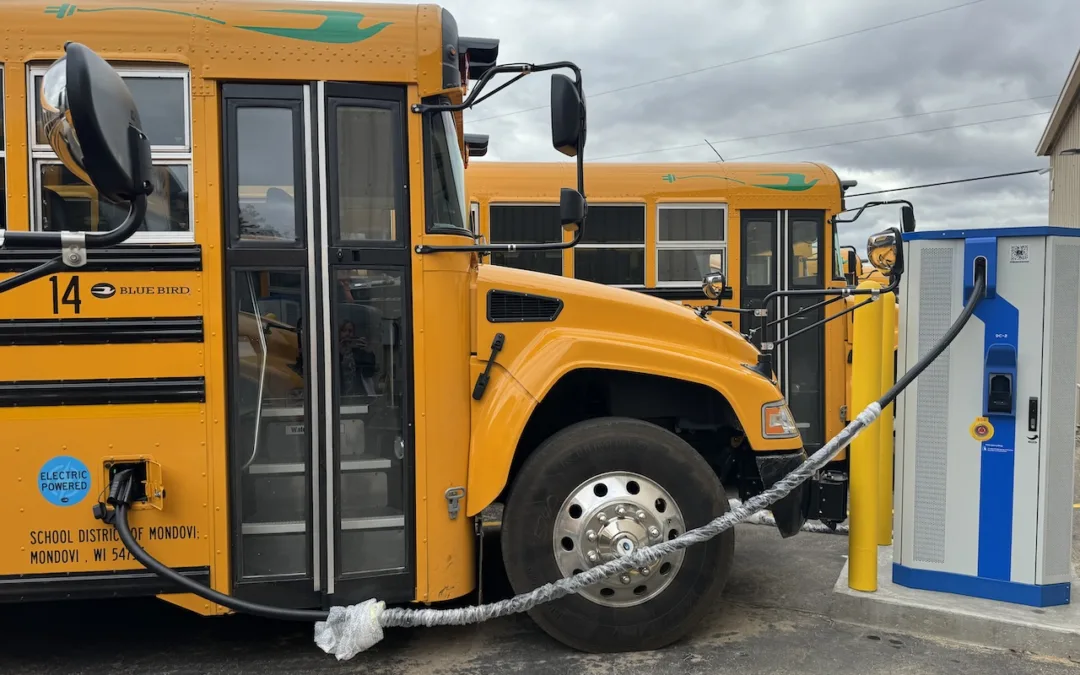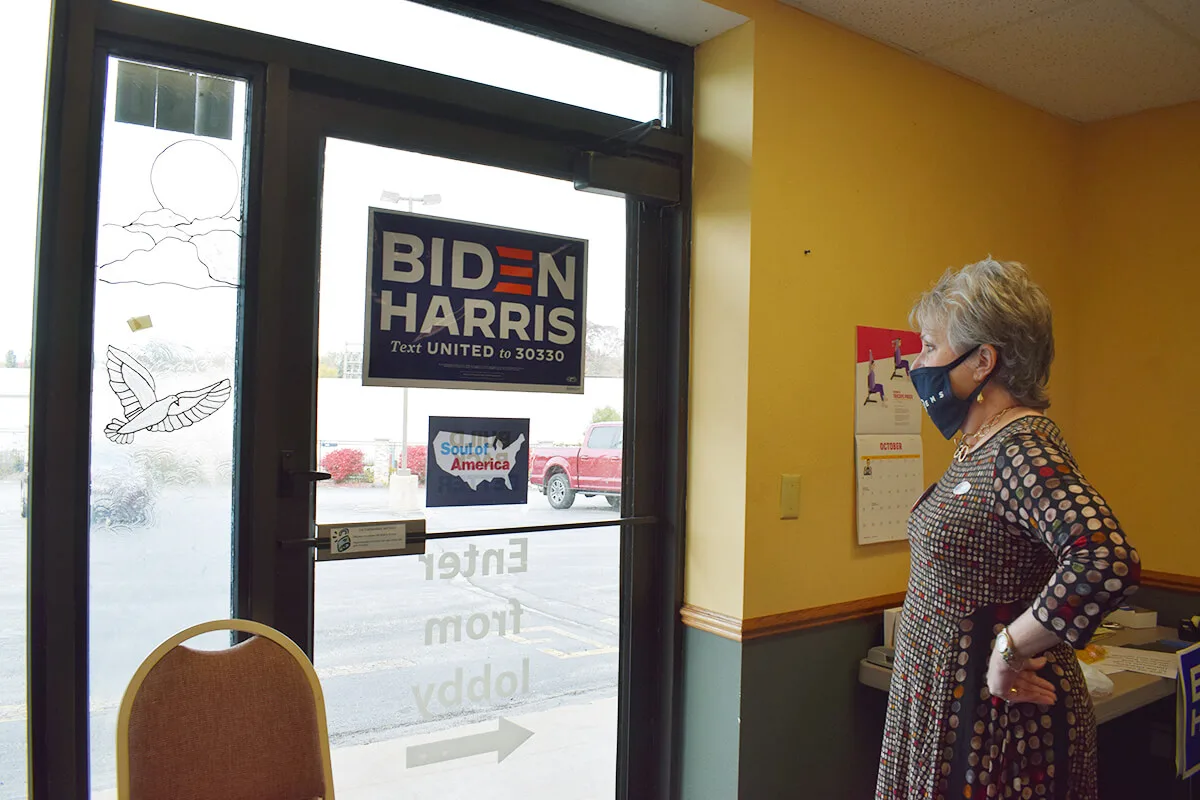
#image_title
#image_title
How the least-populous county near Milwaukee is making incremental changes.
As the results of next week’s presidential election roll in, Deb Dassow isn’t looking for Democratic presidential nominee Joe Biden to carry her home county.
Instead Dassow, the chairwoman of the Ozaukee County Democratic Party, is crossing her fingers for Biden to win just 40% of the vote in a continuation of a slow-but-steady shift to the political left for her home, a Republican stronghold.
“Will Joe Biden win Ozaukee County? No,” said Dassow, seated in the party’s first-ever field office near downtown Grafton (she beamed with pride as she showed a reporter around the office, which has seen scarce use during the coronavirus pandemic). “But he’s going to win wards in some of our cities. He’ll win some wards in Cedarburg, he’ll win some wards in Port Washington. He may win some wards in Mequon.”
Whenever Wisconsin’s results are published after the election, an obscene amount of attention will undoubtedly be given to the state’s many suburban communities—perhaps none will be more poked and prodded than the legendary “WOW” counties surrounding Milwaukee—as analysts dissect President Donald Trump’s performance in the suburbs.
Suburbs, particularly densely populated ones, have made a leap to be seen as the premier prize in American politics, with their literal continued existence becoming a talking point of Trump during the 2020 campaign as he nonsensically claims only he can save suburbs from crumbling under riots and chaos. The sitting president’s pitch to the suburbs has veered between racist (he advocated for less affordable housing, a move to keep people of color from moving to the suburbs) and sexist (he tried to court suburban women first by pleading then by saying he will get “husbands back to work”).
All of this has led to significant losses for Republicans in the suburbs, especially among white women. And yet Democrats have struggled to make significant inroads in the suburbs of Milwaukee, a true-blue city of 600,000 surrounded by about 1.4 million other residents in a sea of red and a handful of purple cities.
Milwaukee county is utterly boxed-in by the WOW counties—Washington, Ozaukee, and Waukesha counties, to the northwest, north, and west, respectively—which practically always vote in tandem, churning out relatively similar margins of victory for Republican candidates in every presidential election since 1964.
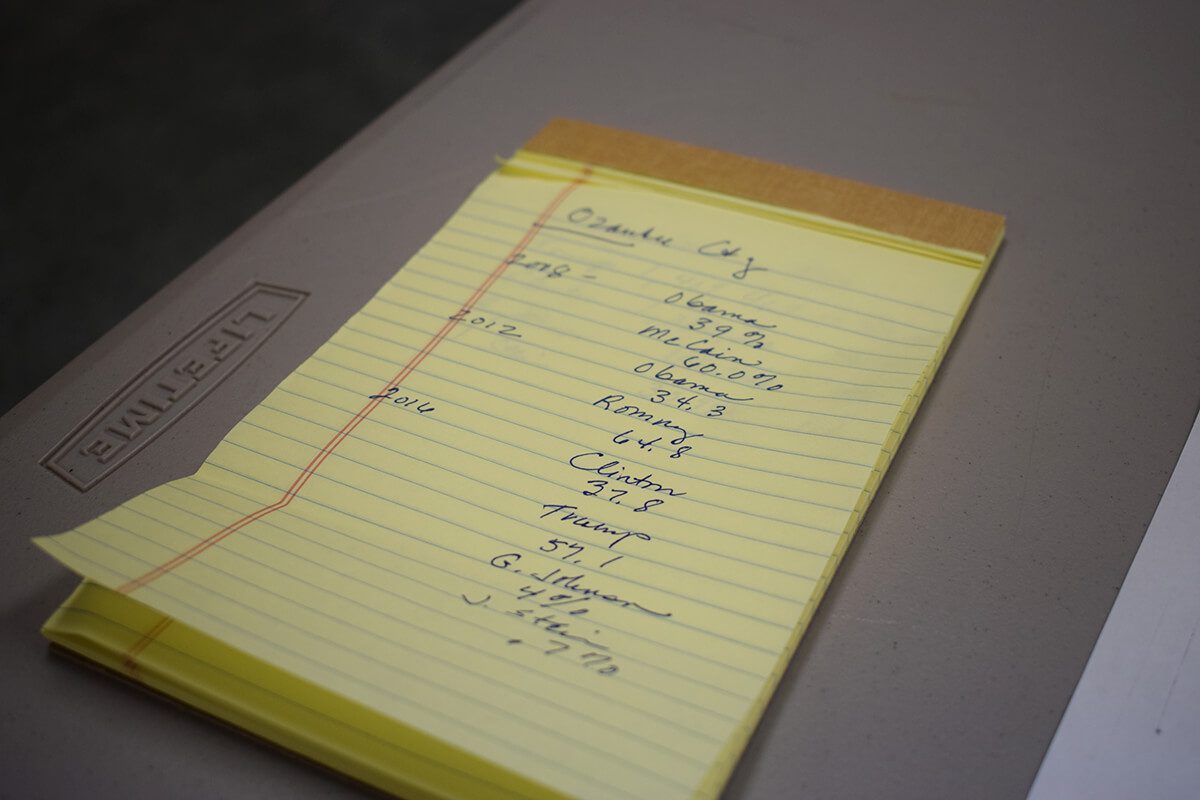
While the Democratic gains are small in the WOW counties, nowhere have the gradual shifts been more pronounced than Ozaukee County, home to about 89,000 people to the north of Milwaukee. Its residents are about 94% white, are incredibly well-educated with a 96% high school and 48% college graduation rate, and have an astounding median household income of almost $83,000.
Most surprising about Ozaukee’s crawl toward Democrats is that it is the least-populous of the three WOW counties—a notion that goes against the conventional wisdom that more populous areas are more Democratic. Waukesha County is home to 404,000 residents, while Washington has 136,000.
Ozaukee’s largest city is Mequon, with a population of 24,000; from there, it falls off quickly to Port Washington, population 11,900, and Cedarburg, population 11,600. Unlike Waukesha, Ozaukee doesn’t fit the traditional mold of a suburban area one might expect to be moving slightly to the left. Yet its proximity to Milwaukee’s well-to-do north-shore suburbs seems to have allowed Democrats to punch above their weight in recent years.
Take the past two presidential elections: Barack Obama received 34.3% of the vote in Ozaukee County in 2012, while Hillary Clinton took home 37% while leaving about 5% of the vote on the table to third-party candidates. Meanwhile, Trump’s 55.8% of the vote share was a nine-point slide from 2012 Republican nominee Mitt Romney and the worst showing for a Republican presidential candidate in the county since Bob Dole’s 56.3% in 1996 against Bill Clinton.
In Washington County, Clinton actually lost ground from Obama as the Democratic vote share dropped from 29.4% to 27.2%. In Waukesha, Obama garnered 32.3% of the vote while Clinton mustered a slightly improved 33.3%.
Heading into next week, Ozaukee County Democrats hope to continue the trajectory of the past two elections. The objective isn’t shooting for the stars—a flip of the historically Republican county, or even turning it purple anytime soon—but instead incremental gains.
Dassow said she’d be “thrilled” to see Biden get 38% of the vote; she’d be over the moon if he got 40%.
She said her party has seen increased visibility in past years, whether it be through the simple act of putting out yard signs, sending letters to the editor to local newspapers, or marching in local parades.
“What we’ve done is given people permission here to be progressive,” Dassow said. “Because there was a time where if you pulled into a grocery store parking lot with a Democratic bumper sticker, people would quietly walk up to you and say, ‘I thought I was the only one!’”
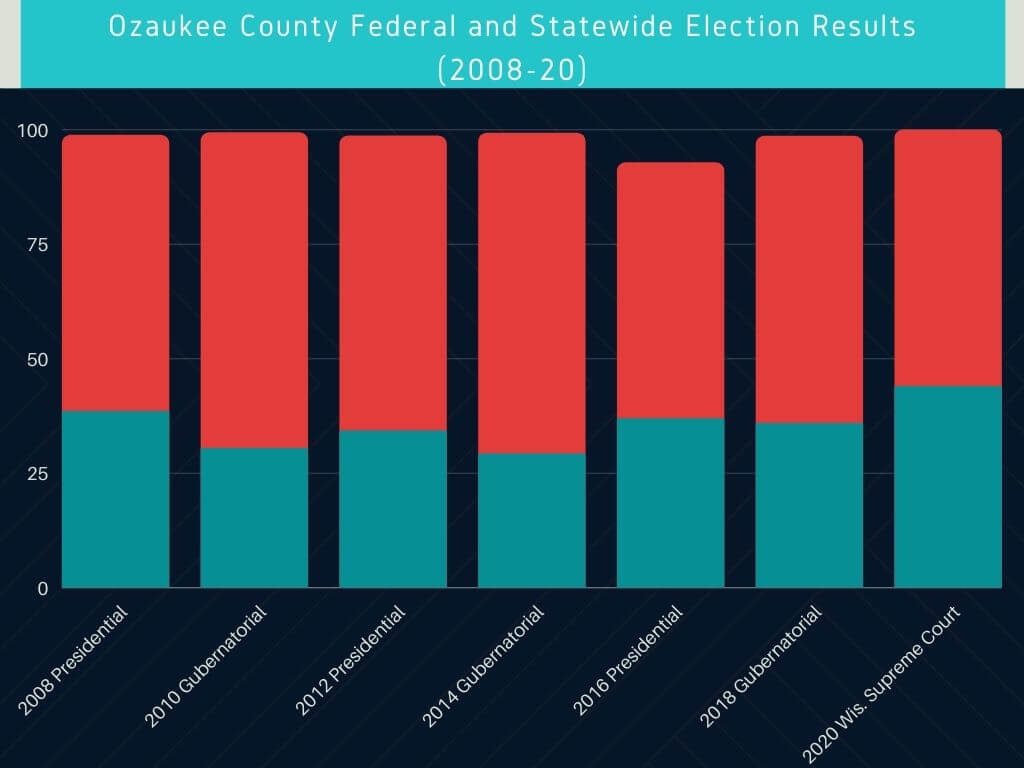
Ozaukee County Republicans hold no illusions about Trump’s performance in the WOW counties next week. He is unlikely to see much of a boost, if any, in 2020, said Van Mobley, spokesman for the county Republican party, an associate history professor at Concordia University, and president of the Village of Thiensville.
“Ozaukee and parts of Waukesha counties, they really like establishment Republican figures like Romney,” Mobley said, contrasting Romney with Trump’s disruptive populist style. “That’s their favorite kind of candidate.”
Despite the relatively underwhelming performance expected from Trump in the WOW counties, Mobley said he anticipates Trump will fare even better than he did in 2016 in the state’s 23 pivot counties, or counties that voted for Obama in 2008 and 2012 but suddenly broke for Trump in 2016. He thinks Trump will carry the state by about 50,000 votes, more than double his miniscule 23,000-vote margin in 2016.
If the 2018 gubernatorial election and this April’s state Supreme Court election are any indication, Trump’s performance will be far worse in Ozaukee County than 2016.
Ex-Gov. Scott Walker, the conservative darling of the previous decade, had a huge backward slide in Ozaukee from his re-election in 2014 to his defeat in 2018. After Walker’s failed presidential run and his championing of the cartoonishly incomplete Foxconn deal—which Trump also played a significant part in—the then-governor’s support in Ozaukee County significantly regressed, dropping from 70% to 62.7% between elections.
Current Gov. Tony Evers earned 35.9% of the vote, a massive improvement over 2014 Democratic gubernatorial nominee Mary Burke, who scored 29.3%. It was the largest swing toward Democrats of any county in the state for that election. (Walker’s numbers had a similar plunge in Waukesha and a small dropoff in Washington between 2014 and 2018.)
This spring’s state Supreme Court election saw an even more impressive Democratic surge, as liberal-backed Jill Karofsky managed to pull 44% of the vote in Ozaukee County as she cruised to statewide victory over incumbent conservative Justice Daniel Kelly, a Walker appointee. Karofsky mustered just 38.5% in Waukesha and 32.1% in Washington.
Dassow conceded it will be almost impossible for Biden to get 44% of the vote, but maintained he will outperform Clinton.
Mobley argued Trump’s three reliably conservative US Supreme Court picks, his plethora of other conservative federal court appointments, good polling numbers for the economy, and his racially charged message of “law and order”—which actually polls poorly in the suburbs—will help shore up support and keep him at around 56% of the vote.
Down ballot races in Ozaukee County are also drawing intrigue ahead of the election. Democrats Deb Andraca and Emily Siegrist have legitimate chances to unseat incumbent Republican state Reps. Jim Ott and Dan Knodl, respectively. Ott’s district stretches along the eastern Lake Michigan shore of northern Milwaukee County and up through eastern Ozaukee County to Port Washington, while Knodl’s begins in northern Milwaukee County about half a mile inland and stretches northwest through southern Ozaukee County all the way to southeastern Washington County.
CNAlysis, a nonpartisan analysis of almost every state-level legislative race in the nation, projects Andraca will flip Ott’s seat, the 23rd Assembly District. Knodl is narrowly favored to keep his seat in the 24th District, according to CNAlysis.
“The 23rd District I’ve always said is kind of a microcosm of what’s been going on all across the country, where you have suburbs that were once reliably Republican that are now trending Democrat,” said Andraca, who lives in the Milwaukee part of the district, which includes affluent majority-white suburban villages like Whitefish Bay and Fox Point.
Ott has represented the 23rd Assembly District since 2007.
Mobley and Andraca both agreed that trend has accelerated in Ozaukee County in places such as Thiensville, Grafton, and Mequon, where new apartment and housing developments have in recent years been drawing a steady stream of new, younger, more diverse residents.
“Probably you look at it, and [there are] 200 new voters, 250 maybe even,” Mobley said of Thiensville, which has a population of about 3,100.
Asked whether these voting and demographic shifts have caused alarm among Ozaukee Republicans as they prepare for future elections, Mobley did not hesitate.
“I think we have concern now,” Mobley said. “We run scared all the time. You obviously always want to win by as much as possible, so we’ll see.”
Politics

What’s the difference between Eric Hovde and Sen. Tammy Baldwin on the issues?
The Democratic incumbent will point to specific accomplishments while the Republican challenger will outline general concerns he would address....
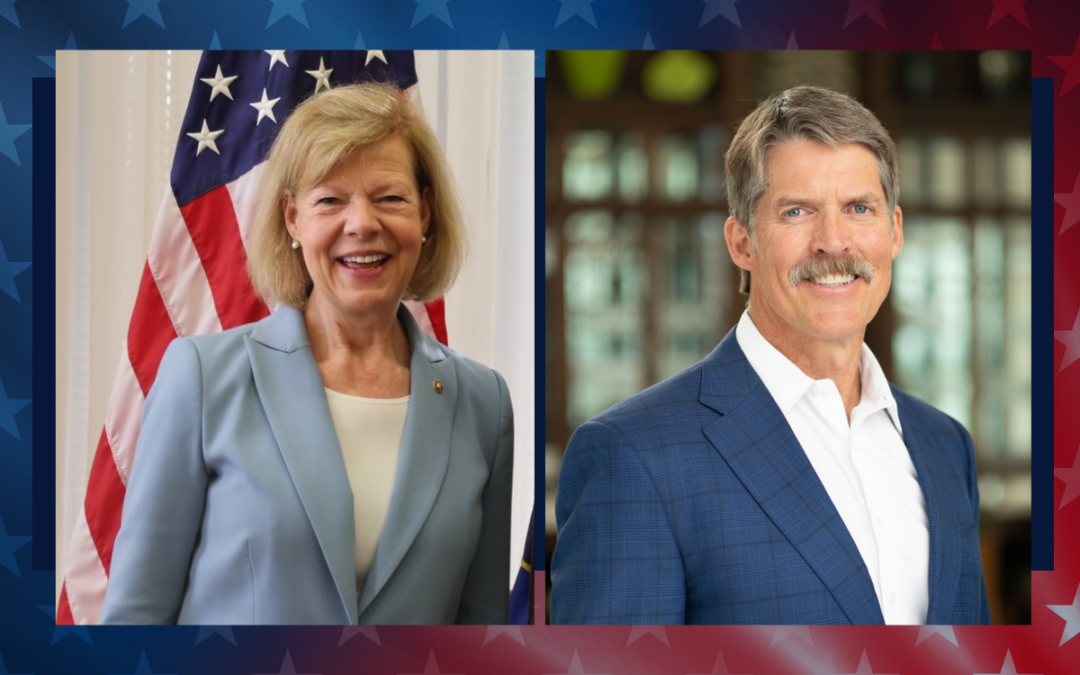
Who Is Tammy Baldwin?
Getting to know the contenders for this November’s US Senate election. [Editor’s Note: Part of a series that profiles the candidates and issues in...
Local News

8 Wisconsin restaurants Top Chef judges are raving about
Top Chef’s 21st season is all about Wisconsin, and on-screen, it’s already apparent that the judges feel right at home here. But, while filming in...

Stop and smell these native Wisconsin flowers this Earth Day
Spring has sprung — and here in Wisconsin, the signs are everywhere! From warmer weather and longer days to birds returning to your backyard trees....


